How does the way we live impact our environment?
"The land was ours before we were the land's" wrote the poet Robert Frost. Since the earliest days of humans on Earth, people have adapted to the physical landscape around them. It shapes the food they eat, the homes they build, the way they move around and the environment they live in. Studying environmental history involves understanding relationships — and sometimes trade-offs — that people make with the landscapes around them.
Environmental Factors
The land itself is the most important factor in human settlement. Do we live in the mountains, on the plains, in the forest, on a river or on the beach? Or on an island? Rivers and oceans were the first human highways. Ships moved people and goods faster and easier than people and animals on land could. Mountains and forests impeded transportation, which could have been a problem or a benefit if it protected residents from outsiders. Ocean-front housing could provide a mild climate or subject inhabitants to brutal storms. Iowans are blessed with incredibly rich soil and rainfall while desert people must be creative to grow food or raise livestock. Where we live has a major impact on the lifestyle of any people.
The air humans breathe is also a factor in our environment. For most of human history, the quality of the air has not been impacted by human activity, but with the Industrial Revolution and a demand for energy from fossil fuels like coal or gasoline, people have polluted the air with carbon products that can create a variety of challenges, like smog or acid rain. Oxygen-depleting pollutants have reconfigured the layers of air surrounding the earth leading to warming temperatures and evolving rainfall patterns.
Water also is an important environmental factor. When water is in short supply, efforts sometimes divert rivers for agriculture or store it behind massive dams to create hydroelectric power. Fertilizer run-off from farm fields seeps into underwater water reserves or flows into rivers and streams altering natural balances.
Renewable Energy
Some energy sources like wind power or sun light are termed renewable energy sources because using them does not decrease their availability. Fuels derived from plant matter like wood, natural gas, oil or coal are nonrenewable sources because they can be depleted. For the most part, fossil fuels present the greatest environmental challenges because they increase the amount of carbon dioxide in the air. Nuclear fuels pose the danger of increased radioactivity when a reactor malfunctions and nuclear wastes create a problem for disposal. When nations were conducting nuclear tests in the atmosphere, radioactive drift traveled far beyond the test site to threaten resources thousands of miles away.
Environmental protection challenges a world divided into nation states because human activity can impact land, the air and water far beyond the site were the activity occurs. Keeping our world safe is a truly world challenge.
Supporting Questions
Why are landforms important?
- Sierra Nevada Mountain Pass, 1867 (Image)
- Valley of the Mississippi River near Clinton, Iowa, 1899 (Image)
- Des Moines River Valley, 1901 (Image)
- Grand Canyon in Arizona, 1913 (Image)
- Zion National Park in Washington County, Utah, 1993 (Image)
- Sweet Corn Field near Marengo, Iowa, August 8, 2016 (Image)
What are renewable and nonrenewable resources?
- Mississippi River Power Plant in Keokuk, Iowa, 1910 (Image)
- Thomas Lake Logging Camp, April 21, 1910 (Image)
- Harvesting Wheat in Walla Walla County, Washington, between July and September 1941 (Image)
- Remains of the Old Carissa Gold Mine in South Pass City, Wyoming, May 27, 2016 (Image)
- Farm Scene with Wind Turbines in Hardin County, Iowa, August 18, 2016 (Image)
What impact do people have on our environment?
- Cabinet Portrait of Iowa U.S. Representative John Lacey, ca. 1890 (Image)
- U.S. Rep. John Lacey’s Bill about the Department of Agriculture, 1900 (Document)
- President Theodore Roosevelt and Conservationist John Muir on Glacier Point, 1903 (Image)
- Letter from Louis Hermann Pammel to the Bank President in Steamboat Rock, Iowa, December 27, 1916 (Document)
- "Legislation on State Parks" Essay from The Annals of Iowa, 1921 (Document)
- Louis Hermann Pammel Speaking at Dedication of Ledges State Park in Iowa, October 9, 1924 (Image)
- Iowa State Parks including Lakes and Streams, 1927 (Map)
- Polluted Stream in Dubuque, Iowa, April 1940 (Image)
- Girl Scout in Canoe Picking Up Trash in Potomac River, April 22, 1970 (Image)
- Traffic on Interstate 405 in Los Angeles, California, 2012 (Image)
- Aerial View of Four-Way Interchange in Los Angeles, California, Date Unknown (Image)
| Environmental Impact Source Set Teaching Guide |
| Printable Image and Document Guide |
Sierra Nevada Mountain Pass, 1867
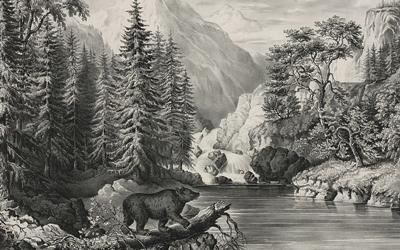
Description
This print shows a wilderness scene with a bear at the edge of a stream and waterfalls and mountains in the background. It is an image of a mountain pass in the Sierra Nevada Mountain Range near Lake Tahoe. This pass was a point on the Carson Trail during…
Valley of the Mississippi River near Clinton, Iowa, 1899

Description
This photograph captures the Mississippi River Valley near Clinton, Iowa, in 1899.
Des Moines River Valley, 1901
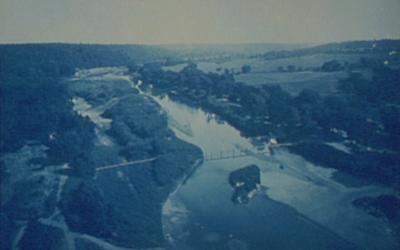
Description
This photograph, taken in 1901, shows a bird's-eye view of the Des Moines River in Iowa.
Grand Canyon in Arizona, 1913
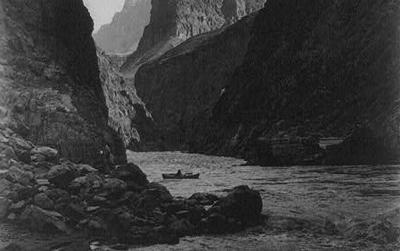
Description
This 1913 photograph shows the Grand Canyon. A small boat can be seen floating on the Colorado River.
Zion National Park in Washington County, Utah, 1993
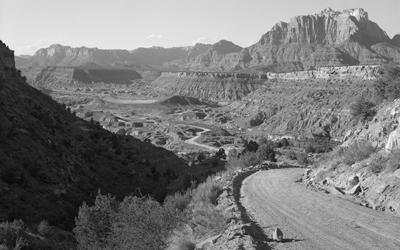
Description
This photograph, taken in 1993, shows Zion National Park in Washington County, Utah.
Sweet Corn Field near Marengo, Iowa, August 8, 2016
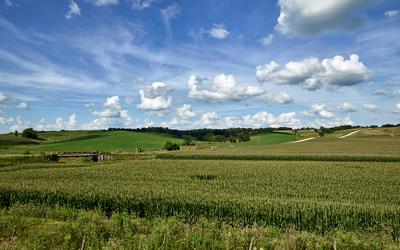
Description
A field of sweet corn near Marengo in Iowa County, Iowa, is shown in this photograph by Carol Highsmith. The photo was taken in 2016.
Mississippi River Power Plant in Keokuk, Iowa, 1910

Description
This photograph, taken in 1910, shows a Mississippi River power plant in Keokuk, Iowa. The power plant was owned by Union Electric.
Thomas Lake Logging Camp, April 21, 1910

Description
This photograph captures the Thomas Lake Logging Camp. The photo shows lumberjacks, logs and a steam-powered logging machine on a railroad.
Harvesting Wheat in Walla Walla County, Washington, between July and September 1941
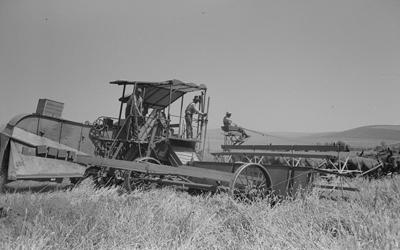
Description
The photograph shows a combine harvester in Walla Walla County, Washington. A combine is able to reap (cut), thresh (separate grain) and winnow (blow air through) grain, such as wheat, which is shown in the photo.
Remains of the Old Carissa Gold Mine in South Pass City, Wyoming, May 27, 2016

Description
This photograph by Carol Highsmith shows the remains of the old Carissa Gold Mine in South Pass City, Wyoming. South Pass City used to be a mining boomtown of 2,000 people in the 1860s in what is now Fremont County. By 1949, miners, speculators and businessmen, finding…
Farm Scene with Wind Turbines in Hardin County, Iowa, August 18, 2016
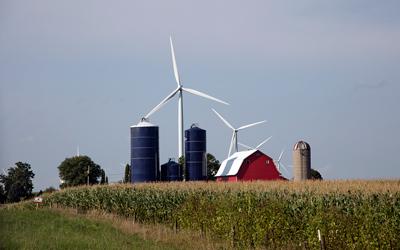
Description
This 2016 photograph by Carol Highsmith shows a farm scene that includes a bright-red barn, three silos (one vintage, two modern) and modern wind turbines in Hardin County, Iowa.
Cabinet Portrait of Iowa U.S. Representative John Lacey, ca. 1890
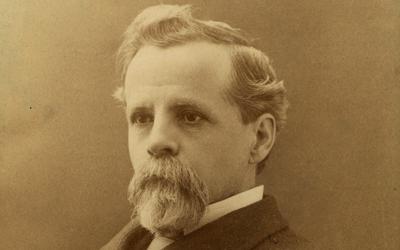
Description
In 1888, John Lacey was elected to the U.S. House of Representatives for the state of Iowa until 1906. Lacey worked on the Bird and Game Act in 1900, also known as the Lacey Act, which stopped transportation of wild animals or birds killed in violation of state laws.…
U.S. Rep. John Lacey’s Bill about the Department of Agriculture, 1900

Description
This 1900 bill from U.S. Rep. John Lacey of Iowa in the House of Representatives focused on enlarging the powers of the Department of Agriculture.
President Theodore Roosevelt and Conservationist John Muir on Glacier Point, 1903

Description
This photograph shows President Theodore Roosevelt with famous conservationist and environmentalist John Muir on a camping trip at Glacier Point, which would later become Yosemite National Park. Muir took Roosevelt to Yosemite in an attempt to…
Letter from Louis Hermann Pammel to the Bank President in Steamboat Rock, Iowa, December 27, 1916
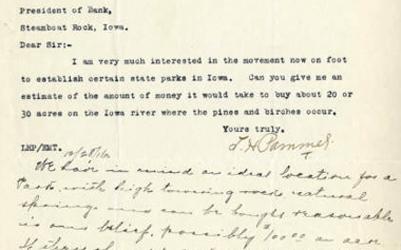
Description
This document is a letter from Louis Hermann Pammel, a botany professor at Iowa State University, to the president of the bank in Steamboat Rock, Iowa. In the letter, Pammel is requesting funds and land for future state parks in Iowa.
"Legislation on State Parks" Essay from The Annals of Iowa, 1921

Description
This essay from The Annals of Iowa is about why and where a state park can be located in the state of Iowa.
Louis Hermann Pammel Speaking at Dedication of Ledges State Park in Iowa, October 9, 1924

Description
The photograph shows Louis Hermann Pammel, a botany professor at Iowa State University, speaking at the dedication of Ledges State Park, which is near the town of Boone, Iowa. In the photo, from left to right, are Iowa Secretary of State Walter C. Ramsey, Ledges State…
Iowa State Parks including Lakes and Streams, 1927
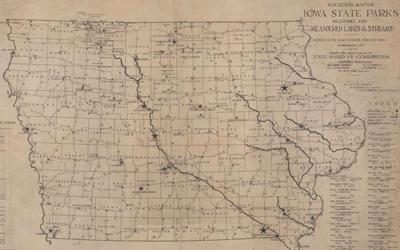
Description
This map of Iowa shows the locations of its state parks in 1927.
Polluted Stream in Dubuque, Iowa, April 1940
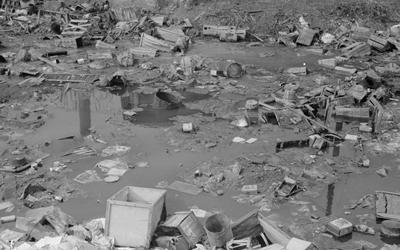
Description
This photograph from 1940 shows a polluted stream in Dubuque, Iowa. Dubuque's main industry was manufacturing, and these large companies lacked proper waste disposal in the city in the 1940s.
Girl Scout in Canoe Picking Up Trash in Potomac River, April 22, 1970

Description
This photograph by Thomas J. O'Halloran shows a girl scout in a canoe picking trash out of the Potomac River. She was taking part in an outdoor clean-up activity during Earth Week in 1970.
Traffic on Interstate 405 in Los Angeles, California, 2012
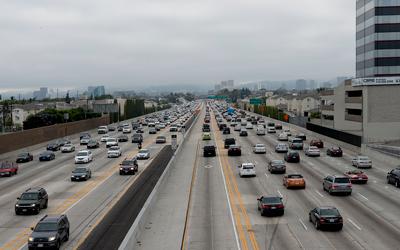
Description
This photograph shows traffic in Los Angeles on an interstate highway in 2012. This interstate, I-405, is a heavily traveled freeway by both people and semi-trailer trucks along its entire length. It is the busiest and most congested freeway in the United States.
Aerial View of Four-Way Interchange in Los Angeles, California, Date Unknown
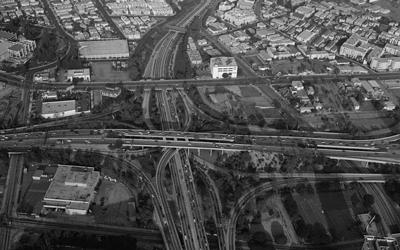
Description
This photograph by Brian Grogan shows an aerial view of a four-level interchange at Arroyo Seco Parkway and Highway 101. This interchange is located in Los Angeles, California.
Additional Resources
- U.S. National Parks for Kids - Landforms
This website allows students to use an interactive map to research national parks throughout the country. This specific webpage focuses on landforms, such as mountain ranges, lakes and rivers. - Gaylord Nelson Letters
This online collection includes letters from elementary school students to Wisconsin politician Gaylord Nelson about pollution. - First Earth Day - April 22, 1970
This history.com webpage about "This Day in History" focuses on the very first Earth Day, which was championed by Senator Gaylord Nelson of Wisconsin, a staunch environmentalist who hoped to provide unity to the grassroots environmental movement and increase ecological awareness. - Clean Air and Water Act
This Environmental Protection Agency (EPA) webpage has a summary of the Clean Air and Water Act, which was passed in 1972. - The Wartville Wizard by Don Madden
This children's book focuses on the imaginary town of Wartville, which is being buried in trash. Then one day, one tidy man realizes he has the power to get rid of all the trash forever and teach his town about their responsibility to keep their land free of trash. - The Camping Trip That Changed America: Theodore Roosevelt, John Muir, and Our National Parks by Barb Rosenstock
This illustrated story book begins in 1903 when President Theodore Roosevelt joined naturalist John Muir on a trip to Yosemite. Camping by themselves in the uncharted woods, the two men saw sights and held discussions that would ultimately lead to the establishment of America's national parks. - A River Ran Wild by Lynne Cherry
"A River Ran Wild" tells a story of restoration and renewal. The book focuses on the modern-day descendants of the Nashua Indians and European settlers were able to combat pollution and restore the beauty of the Nashua River in Massachusetts. - U.S. Landforms (TrueBooks: US Regions) by Dana Meachen Rau
This book allows readers to learn about the nation's deserts, mountains and plains. There are numerous photographs of famous landmarks, such as California's Death Valley and the hot water geysers of Yellowstone National Park. - The Lorax by Dr. Seuss
This well-known book by children's author, Dr. Seuss, chronicles the plight of the environment and the Lorax, who speaks for the trees against the Once-ler, who is cutting them down. - Our Natural Resources by Jennifer Overend Prior
This children's book includes colorful images, supporting text, a glossary, table of contents and index that all work together to help readers better understand the importance of natural resources.
Iowa Core Social Studies Standards (2nd Grade)
Listed below are the Iowa Core Social Studies content anchor standards that are best reflected in this source set. The content standards applied to this set are high school-age level and encompass the key disciplines that make up social studies for second-grade students.
| No. | Standard Description |
| SS.2.8. | Explain the purpose of different government function. |
| SS.2.9. | Develop an opinion on a decision about a local issue. (21st Century) |
| SS.2.11. | Evaluate choices about how to use scarce resources that involve prioritizing wants and needs. |
| SS.2.13. | Describe examples of the goods and services that governments provide. |
| SS.2.19. | Make a prediction about the future based on past related events. |
| SS.2.21. | Compare perspectives of people in the past to those in the present with regards to particular questions or issues. |
| SS.2.22. | Identify context clues and develop a reasonable idea about who created the primary or secondary source, when they created it, where they created it and why they created it. |
| SS.2.23. | Describe the intended and unintended consequences of using Iowa’s natural resources. |